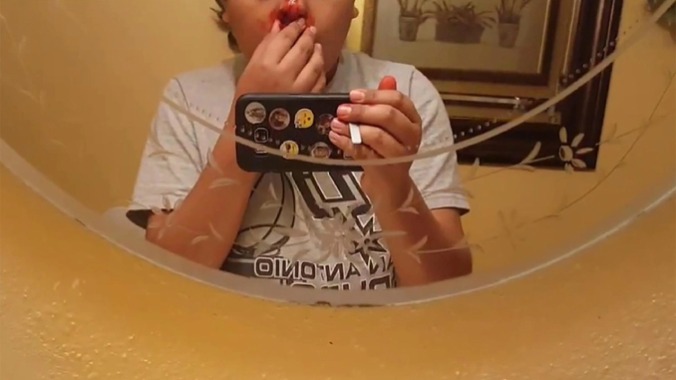Watching Watchers Watch: On the Early Films of Jane Schoenbrun

Read an interview with Jane Schoenbrun, the writer/director of the masterful I Saw the TV Glow, and you are just as likely to encounter a reference to film theorist Gilles Deleuze as you are their appreciation for Tom Green’s 2001 cult classic Freddy Got Fingered. A reductive comparison of the two might describe one as “highbrow” and the other as “low.” Yet what is so refreshing about Schoenbrun’s own art is how such distinctions of “high” and “low” collapse in on themselves, creating a blend emblematic of today’s online film culture—one, at its best, full of autodidactic fans just as appreciative of one extreme as they are the other.
Rightly hailed as one of 2024’s best films, I Saw the TV Glow not only marks an exciting new chapter in Jane Schoenbrun’s budding, already essential oeuvre, but, as critic Willow Catelyn Maclay writes, it is also one of a handful of recent films, along with Vera Drew’s The People’s Joker and Alice Maio Mackay’s T-Blockers, “ushering in a new age of trans film.” I Saw the TV Glow takes place across decades, centering on Owen (played first by Ian Foreman, then Justice Smith), who we first meet as a seventh grader. In the cafeteria, Owen begins a conversation with the older Maddy (Brigette Lundy-Paine), who tells him about The Pink Opaque, a television show in the style of Buffy the Vampire Slayer. Owen, forbidden from watching the show, hatches a plan to go over to Maddy’s house and secretly watch the latest episode. Soon, the two begin to bond over their love of the series, with Maddy bringing to school VHS copies of each episode for Owen to smuggle home and pop into the VCR. Slowly, the boundary between show and reality begins to blur.
Jane Schoenbrun’s work has consistently taken on a reflexive quality, inviting us to reflect on our own relationship with media, whether it be television shows, videogames or internet trends. Watching Owen watch The Pink Opaque brings to mind a scene from Schoenbrun’s last feature, 2021’s We’re All Going to the World’s Fair. After posting a video of herself taking the “World’s Fair Challenge,” the teenage Casey walks out to a barn or garage-like building next to her home. She lays down on the sofa to watch a calming ASMR video meant for someone who has just experienced a nightmare. Casey projects the video onto the wall of the barn, but before doing so, we watch as she extends her arm and raises the remote control. The camera stays on Casey as she presumably brings up a YouTube-like app and types in the name of the video. We watch a seemingly banal ritual that many of us do each day. The shot sparks reflection of our own relationship with technology. To hold the remote is to turn the television, or, in this case the projected computer image, into an extension of the body.
As the ASMR video ends, the computer exhibits its own kind of life—as it often does in We’re All Going to the World’s Fair—by way of the autoplay feature, which queues up a response to Casey’s “World’s Fair Challenge” video. A concerned viewer, known only as JLB, but eventually revealed as a similarly lonely middle-aged man, warns that she may be in trouble. They begin an anonymous long-term friendship over Skype, with JLB hiding his face. Near the end of the film, the two have a falling out that ends with Casey calling JLB a pedophile. Distraught, he flees to the hollow living room of his bourgeois Long Island McMansion—the Xanadu of our time. He sits on the couch and clutches the television remote, perhaps looking for a distraction, or solace, from the rectangle mounted on the wall. Schoenbrun then cuts to the black, empty flat-screen television, an abyss-like symbol of his pain. JLB soon rushes back to the computer. After several failed attempts to make up with Casey, he places his hand on the computer screen, the blue light washing over it, recalling Ingmar Bergman’s Persona. The illusion of touch is no more.
In a recent interview, Jane Schoenbrun made reference to another Scandinavian auteur, Carl Theodor Dreyer and his 1932 film Vampyr. “So much of that imagery in that film is so haunted and horrifying and strange that it could have been uploaded to YouTube as weird analog horror, as much as it feels totally of its time,” they said. Again, “low” and “high” culture collapse into one another. But the irony inherent to this compliment is that today, many first-time watchers of Vampyr are likely to encounter the film on YouTube, where versions of varying image quality and language exist in the public domain, along with clips, video essays and other analyses of the film—Dreyer’s work sits in dialogue with, well, everything else online.
The moving image ecosystem of YouTube is the subject of Jane Schoenbrun’s 2018 found footage film, A Self-Induced Hallucination, a study of the Slender Man phenomenon, a deliberately manufactured online myth. A Self-Induced Hallucination (available to watch for free here) begins with a recording of Schoenbrun typing on their desktop to contextualize the footage, all of which was uploaded to YouTube between 2009 and 2018. The film recalls the tradition of “desktop documentaries,” including works like Kevin B. Lee’s Transformers: The Premake and Chloé Galibert-Laîné’s Watching The Pain of Others. Such films, including Schoenbrun’s, use the desktop as a canvas to restage the act of watching and, in their specific case, of falling down the Slender Man rabbit hole.
-

-

-

-

-

-

-

-

-

-

-

-

-

-

-

-

-

-

-

-

-

-

-

-

-

-

-

-

-

-

-

-

-

-

-

-

-

-

-

-








































